
There is a common set of root causes for the poor quality of urban life, says Subir Roy
An urban crisis is upon us -- Delhi’s air pollution, Chennai’s floods, Bengaluru’s garbage.
This is not something unknown or unanticipated, merely the culmination of a long process.
A study by Janaagraha, a Bengaluru-based non-government organisation focused on improving the quality of life in urban India, has found that urban issues prominent in public discourse have not changed in 30 years.
Adopting a drastic cure cannot be postponed any longer.
This needs diagnostic tests that yield rich data.
Janaagraha has released its third Annual Survey of India’s City-Systems (ASICS 2015) which is now a source of comparable data over a period of time that gives experts a chance to get to the roots of the malaise.
The depressing overview, according to Janaagraha’s founder and leader, Ramesh Ramanathan, is that over the three-year period little has changed.
The scores of leading Indian cities under the chosen parameters remain at about the same low levels.
Popular discourse on India’s urban malaise is usually focused on symptoms but it is “the disease that needs to be treated,” observes Srikanth Viswanathan who has led the ASICS research.
There is a common set of root causes for the poor quality of urban life.
These have been brought under a city-systems framework that has four interconnected components: planning and design; capacities and resources; empowerment and political representation; and transparency, accountability and participation.
If you adopt this approach, you address systemic issues which hold our cities back.
Ultimately, it is not resources which hold back the 21 cities in 18 states -- including all the state capitals -- that ASICS covers, but governance.
A reform agenda is needed to fix the vacuum in local governance.
The centre and the states have to cooperate to empower urban local bodies so that they can deliver, be accountable and transparent.
But politicians are by nature statusquoists who will not voluntarily give up power.
How the tipping point will come to enable change is the cardinal conundrum hanging over non-functional city systems.
ASICS 2015 reveals that most cities cannot implement their spatial development plans.
Even when there are plans they do not synchronise, as in the case with the plans for the local bodies coming under the Mumbai metropolitan area.
In Bengaluru, the boundaries of various bodies that deliver water, power and transport do not coincide. Ergo, confusion.
Absolutely no city has an effective mechanism to deter planning violations.
In Delhi, over 30 per cent of the population lives in unauthorised colonies.
This is after over 2,200 of them have been regularised. Since 1947 over 3,000 colonies have been authorised.
Most cities severely lack the ability to raise their own resources. Payment of salaries and wages leaves little for capital expenditure, thus making cities dependent on central and state governments.
It is rich cities like Mumbai and Delhi and a relatively well-run city like Pune that mostly make the cut.
The material resource shortage has a companion in the shortage of human skills. Adequate manpower with the right skills, and stability of leadership, are critical issues.
There are close to 8,000 census towns but only 5,000 town planners in the country.
The average tenure of municipal commissioners varies widely, from under one year for Raipur to over four years for Ahmedabad.
How well material and human resources are used and what kind of leadership a city has is reflected in its use of information technology. Cities like Bhopal, Delhi, Mumbai, Pune and Surat (again a shortlist of cities with somewhat, only somewhat, better systems) score the best.
An outlier is Chennai which has an overall poor score but has made progress by installing an enterprise IT system from 2009.
Online assessment of property tax and collection, running the workforce with greater efficiency, approving building plans and tracking complaints have all entered a new era.
If there is any one issue which matters then it is empowerment, particularly the role and status of the mayor. Right at the top are cities with directly elected mayors with five-year terms.
Eight out of the 21 cities surveyed (Bhopal, Chennai, Dehradun, Jaipur, Kanpur, Lucknow, Raipur and Ranchi make the cut.)
On the other hand Ahmedabad and Bengaluru get one-year mayors and Mumbai a new one every 2.5 years.
Most unfortunately not a single mayor has the right to appoint the municipal commissioner.
To enable empowerment, a key reform is ensuring devolution of all the 18 functions listed in the 74th Amendment to the Constitution.
One of the most useful sets of data in the survey comes under the rubric of transparency, accountability and participation.
This addresses issues like: does it mandate disclosure of audited financial statements, details of plans, income and budgets? Are internal audits of urban local bodies available in the public domain?
Are there open data standards for financial information (budgets) and annual report on works? Cities which fare well are Hyderabad, Bengaluru, Pune and Mumbai.
Reforms do happen and one example is Odisha which has taken steps to create a dedicated, exclusive municipal cadre for administrators.
This seeks to address the paucity of experts in domains like urban planning and transportation which are making do by relying on the open market, consultancies and outsourcing.
Empowered urban local bodies with powerful democratically elected mayors for respectable terms, aided by officials who have a career stake in local government, offer the foundations on which a viable urban India can be built.
Image: Holi celebrations in Ahmedabad. Photograph: Amit Dave/Reuters










